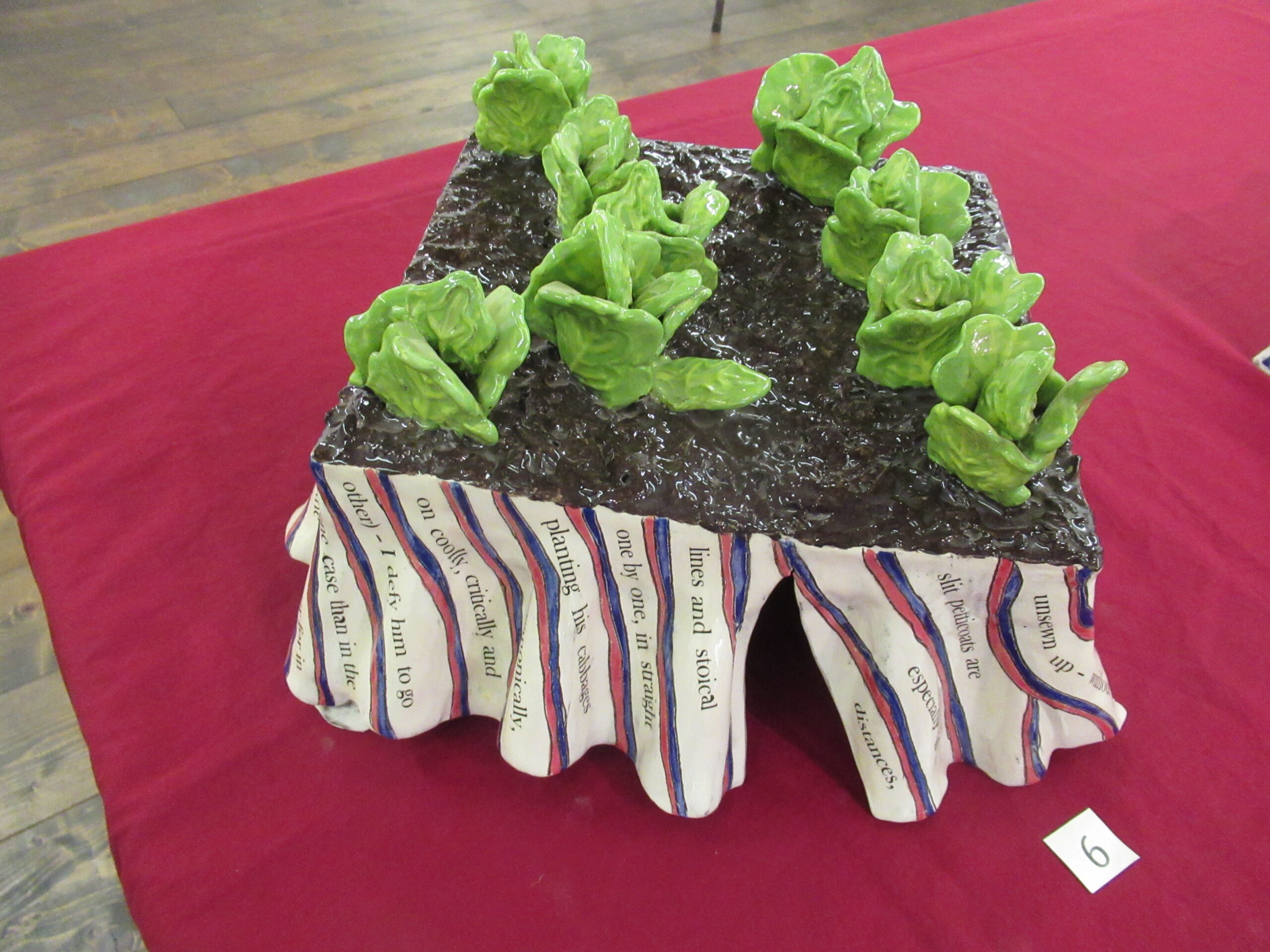In the gallery at Shandy Hall at the moment is an exhibition of ingenious ceramics by Katrin Moye. Entitled Filthy trash, it takes its inspiration from an aspect of Laurence Sterne’s Tristram Shandy that’s obvious, but often skated over by scholars more interested in its grander themes, like time, digression and reflexivity – its sly obscenity.
In her exhibition note and her short video, Katrin recalls how, once she’d conceived the idea of creating Shandy-related Staffordshire-style sculptures, she found herself lost in the sea of endless possibilities offered by Sterne’s roomy novel. Until, that is, she ‘went back to basics’ and decided to concentrate on its humour, and specifically its obscene and scatological jokes. The result is nine pieces, each focussed on a single joke, plus a series of chamber pots and noses.
Sterne’s jokes sometimes rely on eighteenth-century references that tend to elude us these days. The human nose, an obsession of Tristram’s father throughout his book, stands in for another part of the male anatomy – which is why the accident that demolishes the young Tristram’s nose is so disastrous – but there’s also a reference to the fact that syphilis, a common disease at the time, often ate away the nose, giving rise to a market for synthetic noses. Noses feature strongly in Katrin’s exhibition too: literally, inside the leaves of the book On noses by the historical authority on the subject, Hafen Slawkenbergius; inside some the chamber pots on the floor; and, carefully gift-wrapped inside book-like boxes, available for sale in the gallery. Katrin modelled her noses by taking a cast from Sterne’s distinctive conk, as it appears on the bust by Joseph Nollekens kept in Shandy Hall.
A ceramic chestnut, and the single blasphemous cry of pain ‘Zounds!’, remind us of the story, in Book 4, of Phutatorius, who has left the flies of his breeches undone, only for a hot roasted chestnut to roll off the table and embed itself in his anatomy.
Female genitalia attract Sterne to different images, most concerned with openings, like crevices, buttonholes and keyholes.
In a chapter on noses, in which Tristram insists that ‘where the word Nose occurs—I declare, by that word I mean a nose, and nothing more, or less’, he discusses with Eugenius, his disreputable and disingenuous friend, the connotations of the word ‘crevice’:
——Here are two senses, cried Eugenius, as we walk’d along, pointing with the forefinger of his right hand to the word Crevice, in the one hundred and seventy-eighth page of the first volume of this book of books; ———here are two senses—quoth he—And here are two roads, replied I, turning short upon him——a dirty and a clean one——which shall we take?—The clean, by all means, replied Eugenius.
Katrin’s corresponding ceramic shows a signpost, with the two directions clearly marked.
More than once Sterne promises us a whole chapter on buttonholes, but, typically, it never appears. ‘Keyholes’, he tells us, as Mrs Shandy prepares to put her eye to one in order to observe how Uncle Toby’s lovemaking is going, ‘are the occasions of more sin and wickedness, than all other holes in this world put together’. Katrin shows us the key and keyhole, and lets us decide for ourselves.
My favourite ceramic is a three-dimensional counterpart of a joke about planting cabbages, at the beginning of the section of the amours of Uncle Toby and the Widow Wadman. The beginning of Book 8 resumes from where Book 7 left off, in the south of France:
—But softly—for in these sportive plains, and under this genial sun, where at this instant all flesh is running out piping, fiddling, and dancing to the vintage, and every step that’s taken, the judgment is surprised by the imagination, I defy, notwithstanding all that has been said upon straight lines in sundry pages of my book—I defy the best cabbage planter that ever existed, whether he plants backwards or forwards, it makes little difference in the account (except that he will have more to answer for in the one case than in the other)—I defy him to go on coolly, critically, and canonically, planting his cabbages one by one, in straight lines, and stoical distances, especially if slits in petticoats are unsew’d up—without ever and anon straddling out, or sidling into some bastardly digression—In Freeze-land, Fog-land, and some other lands I wot of—it may be done—
‘Planting a cabbage’ had a clear sexual connotation, so the mention of unsew’d up slits in petticoats isn’t unexpected. But the metaphor gets subsumed in a wider philosophical theme – one of the key themes of the whole book. Tristram Shandy is one long hymn to the unstraight, the irregular, the unmechanical, the ununilinear. Sterne’s personal authorial weapon in this fight is the digression, which will always lead him astray, even in a ‘Freeze-land’ or ‘Fog-land’ like north Yorkshire, from ever completing any narrative. We soon learn that Tristram has not a hope in the world of finishing the writing of his life, and the wooing of Uncle Toby will never reach a conclusion.
Katrin Moye gives us both motifs, sexual and philosophical. Under the cabbage patch, with its straying cabbages, are the folds of a skirt – complete with a single slit – on which are reproduced some of the words of the passage.
All of Katrin’s ‘literary sculptures’ reminds us that pots, however ‘finely’ made, can never escape their earthy origins. If they connect to earthy subjects, so much the better.









Leave a Reply